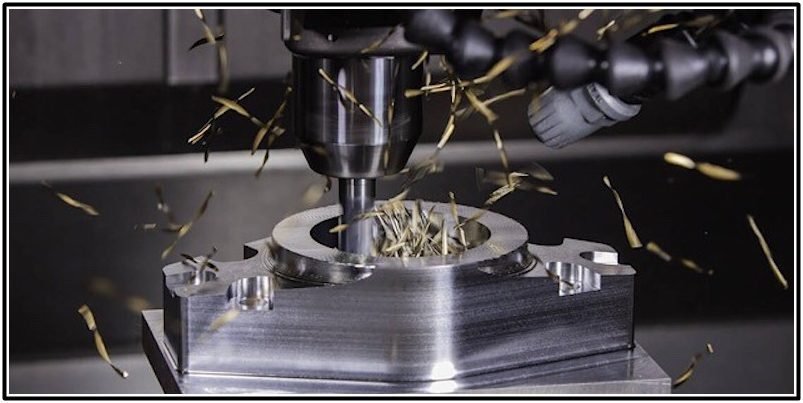Milling is a process that can be used to create different types of CNC milled parts for various applications. There are two main types of milling, down milling and up milling. Down milling is a type of machining where the cutting tool moves downwards, while up milling is a type of machining where the cutting tool moves upwards. Both have their own benefits, but it can be confusing to know which one to choose for your project.
In this blog post, we will explore the differences between down milling and up milling so you can make the best decision for your needs.

Types And Uses Of Milling Cutters
Cutters of different shapes and sizes are used to cut away metal plates to create the desired shape. The most common type of cutter is the end mill, which is used to create circular or slot-shaped cuts. Other types of milling cutters include the face mill, ball end mill, and fly cutter.
End mills are the most common type of milling cutter and are used to create circular or slot-shaped cuts. A wide variety of end mills are available, each designed for specific applications. The most common end mills are made from high speed steel (HSS) or carbide. HSS end mills can be used on both ferrous and non-ferrous materials, but they are not as durable as carbide end mills and tend to wear down more quickly.
Ball end mills are used to create rounded cuts. The ball end mill has a round cutting tip that is connected to a spiral flute. The flutes on the ball end mill help to move the material up and out of the way so that the cut can be made. Ball end mills are available in both HSS and carbide.
Fly cutters are a type of milling cutter that is designed to remove large amounts of material from a workpiece. Fly cutters typically have two or more cutting tips that are mounted on a disc. The disc is attached to a spindle and rotated at high speeds. As the disc rotates, the cutting tips remove material from the workpiece. Fly cutters are available in both HSS and carbide.
Face mills are used to remove large amounts of material from the face of a workpiece. Face mills have a large cutting tip that is connected to a spiral flute. The flutes on the face mill help to move the material up and out of the way so that the cut can be made. Face mills are available in both HSS and carbide.
Down Milling And Up Milling
Down milling is a machining process in which the direction of the cutter is always parallel to the direction of the workpiece, meaning that the cutting edges always point downwards. This type of milling is typically used for workpieces that are too large or too heavy to be milled safely using up milling. It can also be used to create smooth and wide surfaces on a workpiece or remove large amounts of material from a workpiece quickly.
Up milling, on the other hand, is a machining process in which the direction of the cutter is always perpendicular to the direction of the workpiece. This means that the cutting edges always point upwards. Up milling is typically used for smaller and lighter workpieces that can be milled safely without fear ofdamage.

The main advantage of up milling over down milling is that it produces a smoother surface finish. This is because up milling cuts against the direction of grain, while down milling cuts with the grain. Up milling is also less likely to produce chip nests, or areas where the chips have piled up and become stuck.
Another advantage of up milling is that it is less likely to cause vibration. This is because the cutting forces are opposed by the feed forces, rather than in the same direction. As a result, up milling can be used on thinner workpieces without fear of vibration.
Down milling has some advantages over up milling as well. One advantage is that down milling can be used on harder materials, since the cutting forces are in the same direction as the feed forces. Down milling is also more efficient at removing material, since both workpiece and chips are removed in the same direction.
How to Choose
The main advantage of down milling is that it allows the chips to fall away from the workpiece, preventing them from being wedged between the cutter and the workpiece.
Up milling is less common than down milling, but it has some advantages in certain situations. When up milling, the workpiece is fed against the rotating cutter. The main advantage of up milling is that it prevents the formation of burrs on the workpiece.
So, which type of milling is right for your application? Here are some factors to consider:
- The material of the workpiece: Down milling is generally the best choice for harder materials, while up milling is better for softer materials.

- The finish of the finished product: Down milling typically produces a better finish than up milling.
- The size of the chips: Up milling produces smaller chips than down milling, which can be important in applications where chip size is critical.
- The depth of cut: Up milling can be used for shallow cuts, while down milling is typically used for deeper cuts.
- The direction of the grain: When milling along the grain, up milling produces a better finish than down milling. When milling across the grain, down milling is typically the better choice.
So, there are a few factors to consider when choosing between down milling and up milling. In general, down milling is the best choice for most applications. However, up milling has its advantages in certain situations. Ultimately, the best choice depends on the specific application.

